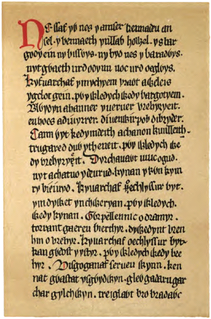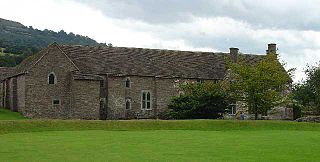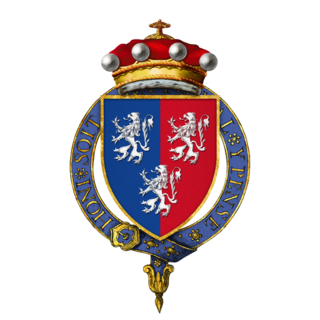
The Red Book of Hergest is a large vellum manuscript written shortly after 1382, which ranks as one of the most important medieval manuscripts written in the Welsh language. It preserves a collection of Welsh prose and poetry, notably the tales of the Mabinogion and Gogynfeirdd poetry. The manuscript derives its name from the colour of its leather binding and from its association with Hergest Court between the late 15th and early 17th century.
Eudaf Hen is a figure of Welsh tradition. He is remembered as a King of the Britons and the father of Elen Luyddog and Conan Meriadoc in sources such as the Welsh prose tale The Dream of Macsen and Geoffrey of Monmouth's Latin chronicle Historia Regum Britanniae. He also figures into Welsh genealogies. Geoffrey of Monmouth calls him Octavius, a corruption and faux-Latinization of Old Welsh/Breton Outham. According to the medieval Welsh genealogy from Mostyn MS. 117, Eudaf was a direct ancestor of King Arthur.

The Black Book of Carmarthen is thought to be the earliest surviving manuscript written solely in Welsh. The book dates from the mid-13th century; its name comes from its association with the Priory of St. John the Evangelist and Teulyddog at Carmarthen, and is referred to as black due to the colour of its binding. It is currently part of the collection of the National Library of Wales, where it is catalogued as NLW Peniarth MS 1.

The Book of Taliesin is one of the most famous of Middle Welsh manuscripts, dating from the first half of the 14th century though many of the fifty-six poems it preserves are taken to originate in the 10th century or before.
Cadair Idris or Cader Idris is a mountain in Gwynedd, Wales, which lies at the southern end of the Snowdonia National Park near the town of Dolgellau. The peak, which is one of the most popular in Wales for walkers and hikers, is composed largely of Ordovician igneous rocks, with classic glacial erosion features such as cwms, moraines, striated rocks, and roches moutonnées.
Lewys Glyn Cothi, also known as Llywelyn y Glyn, was a prominent 15th century Welsh poet who composed numerous poems in the Welsh language. He is one of the most important representatives of the Beirdd yr Uchelwyr or Cywyddwyr ("cywydd-men"), the itinerant professional poets of the period between the 1284 Statute of Rhuddlan and c. 1600.
Dafydd ap Edmwnd was one of the most prominent Welsh language poets of the Later Middle Ages.
Madog ap Gwallter was a medieval Welsh language poet.
Gwilym ab Ieuan Hen was a Welsh language poet during the time of the Beirdd yr Uchelwyr, the professional "Poets of the Nobility".
Maredudd ap Rhys, also spelt Meredudd ap Rhys, was a Welsh language poet and priest from Powys. He was born in gentry, having pedigree blood, as discovered from the Peniarth Manuscripts. He is thought to have been the bardic tutor to Dafydd ab Edmwnd, and thus won distinction both as a poet and as a poetry teacher.

Tudur Penllyn was a Welsh language poet during the time of the Beirdd yr Uchelwyr, the professional poets of the late Middle Ages.

Bacheldre is a small settlement in Powys, Wales. It is near the A489 road and is 5 kilometres (3 mi) southeast of the town of Montgomery.
Ieuan ab Rhydderch ab Ieuan Llwyd was a Welsh bard.
The White Book of Hergest was an important Welsh manuscript compiled in c. 1450. It contained many Welsh poems and prose texts and was a significant source for several antiquaries of the 17th and 18th centuries, but disappeared in the early 19th century, probably being destroyed in a fire in a London bookbinder's shop in around 1810.

Sir Roger Vaughan of Tretower Court, was the son of Welsh noblewoman Gwladys ferch Dafydd Gam and Sir Roger Vaughan of Bredwardine, who fought and died with Gwladys's father, Dafydd Gam in the Battle of Agincourt in 1415.

The Coelbren y Beirdd is a runic alphabet system created in the late eighteenth century by the literary forger Edward Williams, best known as Iolo Morganwg.

Peniarth 20 is an early Welsh manuscript, written on parchment, that is part of the Peniarth collection in the National Library of Wales. It is also known as the Chronicle of the Princes because it contains an important version of the chronicle Brut y Tywysogion. Daniel Huws, the leading authority on Welsh manuscripts, has argued that the majority of Peniarth 20 dates from circa 1330. A date around the 15th century had previously been offered by J. Gwenogvryn Evans.
Ieuan ap Gruffudd Leiaf was a Welsh uchelwr and bard. His poetry, spanning the period c.1420 to c. 1470, has been fully edited. The earliest dateable poem that can be confidently assigned to him are a cywydd in praise of Gwilym ap Gruffudd ap Gwilym ap Gruffudd ap Heilin and his newly-built home, Y Penrhyn, Llandygái. The context of this poem seems to be the tradition of the'cyff clêr', with Ieuan, a 'prifardd', answering the taunts of lesser bards. Rhys Goch Eryri was present at the celebration and composed a perhaps more well-known praise poem to Y Penrhyn and its owner. Shortly after this, Ieuan composed a cywydd satiring the River Llugwy, into which the poet fell on his way to Y Penrhyn one Christmas. A cywydd to Saint Anna, mother of the Virgin Mary and two other daughters also named Mary, attributed to Ieuan in the only manuscript in which it survives, could also be from the same period or earlier.









